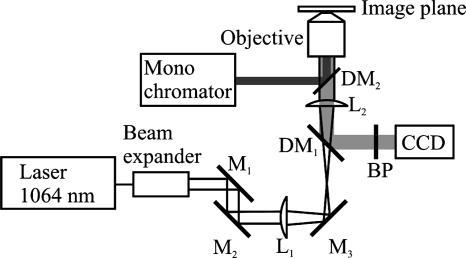FIG. 1.
Drawing of the microscope equipped with optical tweezers and fluorescence. A neodymium-doped yttrium aluminum garnet laser with a wavelength of 1,064 nm was used as the trapping laser. The laser beam is guided through the different optical parts before entering the microscope, where the tube lens is used as the second lens in the tweezers telescope and the laser beam is focused by the water objective (Zeiss C-Apochromat; numerical aperture, 1.2) to form the trap. The fluorescence light is guided from the monochromator via an optical fiber through the fluorescence port on the back of the microscope and reflected into the sample by the fluorescence dichroic mirror (DM2). The fluorescence light is detected by the CCD camera. L1, lens 1; L2, lens 2; DM1, dichroic mirror 1; DM2, dichroic mirror 2; BP, bandpass filter; M1, mirror 1; M2, mirror 2; M3, mirror 3.

